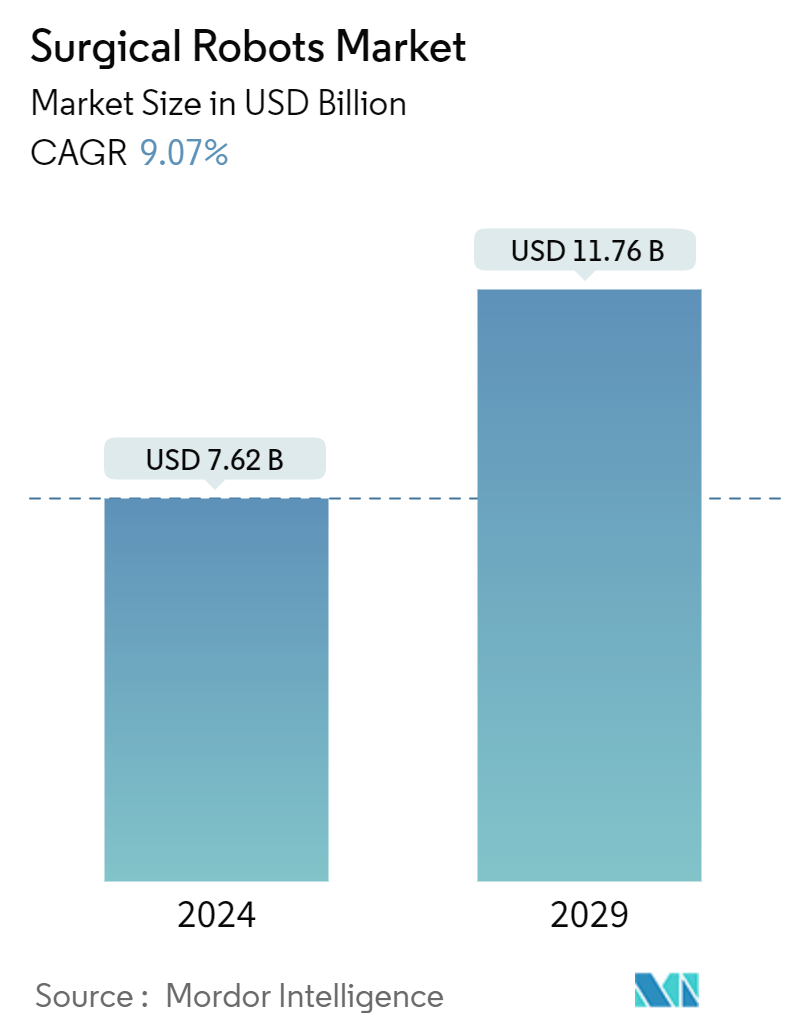Market Size of Surgical Robots Industry

| Study Period | 2019 - 2029 |
| Market Size (2024) | USD 7.62 Billion |
| Market Size (2029) | USD 11.76 Billion |
| CAGR (2024 - 2029) | 9.07 % |
| Fastest Growing Market | Asia Pacific |
| Largest Market | North America |
| Market Concentration | Medium |
Major Players
*Disclaimer: Major Players sorted in no particular order |
Surgical Robots Market Analysis
The Surgical Robots Market size is estimated at USD 7.62 billion in 2024, and is expected to reach USD 11.76 billion by 2029, growing at a CAGR of 9.07% during the forecast period (2024-2029).
The market under study is being driven by the escalating need for automation in the healthcare industry, the prevalence of chronic illnesses, the growing elderly population, the complexity of surgical procedures, and the expanding desire for non-invasive operations with more accuracy and adaptability. Despite this, numerous doctors and engineers developing robotic surgical systems for the Army subsequently started up businesses that provided robotic surgery to the civilian medical community.
- Robotic technology is frequently used in minimally invasive surgeries. As the name implies, these operations all involve small incisions. This technique typically leads to less pain, less blood loss, shorter hospital stays, and quicker recoveries, allowing surgeons to operate on hard-to-reach body parts and get a better view of hidden areas, encouraging patients worldwide to choose robotic surgery and growing market.
- Cancer cases are also aiding the growth of the market. According to National Cancer Institute, the number of cancer incidences is estimated to reach 22 million by 2030; 60% of the cases are expected to occur in Africa, Asia, and Central & South American regions. With advancements in medical diagnostics, cancer detection has become easy. Thus, patients are now opting for surgical procedures to remove the tumor.
- The market's expansion is being hampered by exorbitant installation prices as well as worries about safety and integration challenges. But during the next several years, the cost of the equipment is anticipated to decrease due to advancements in the field of surgical robots. As a result, market penetration is anticipated to rise throughout the projection period.
- During the pandemic, the healthcare system was under a great deal of strain, notably with regard to surgical facilities, respirators, and intensive care unit (ICU) beds. These resources are scarce at a hospital that can experience an unexpected patient inflow, requiring the realignment of ICU beds and the postponement of elective procedures. There was also a chance that patients and healthcare workers may get an infectious disease.
Surgical Robots Industry Segmentation
Robotic surgery is performed by a particularly trained surgeon through tiny incisions. Conditions affecting the bladder, prostate, heart, digestive system, and more can be treated using robotic surgery. The advantages are less blood loss, shorter hospital stays, and speedier recovery. The capacity of surgical robots to precisely manipulate surgical equipment in a restricted operating room is helpful for minimally invasive surgery. Two tiny gripping manipulators, a stiff neuro endoscope, a suction tube, and a perfusion tube, make up the micromanipulator.
The surgical robots market is segmented by component (surgical system, accessory, and service), area of surgery (gynecological surgery, cardiovascular, neurosurgery, orthopedic surgery, laparoscopy, and urology), and geography (North America, Europe, Asia Pacific, Rest of the World). The market sizes and forecasts are provided in terms of value in USD for all the above segments.
| Component | |
| Surgical System | |
| Accessory | |
| Service |
| Area of Surgery | |
| Gynecological Surgery | |
| Cardiovascular | |
| Neurosurgery | |
| Orthopedic Surgery | |
| Laparoscopy | |
| Urology | |
| Other Areas of Surgery |
| Geography*** | |
| North America | |
| Europe | |
| Asia | |
| Latin America | |
| Middle East and Africa |
Surgical Robots Market Size Summary
The surgical robots market is poised for significant growth, driven by the increasing demand for automation in healthcare, the rising prevalence of chronic diseases, and the expanding elderly population. The complexity of surgical procedures and the growing preference for non-invasive operations with enhanced precision and flexibility are further propelling market expansion. Despite challenges such as high installation costs and safety concerns, advancements in surgical robot technology are expected to reduce costs and improve market penetration. The market is also witnessing a surge in demand due to the rising incidence of cancer, prompting more patients to opt for surgical interventions. The adoption of robotic technology in minimally invasive surgeries is gaining traction, offering benefits like reduced pain, less blood loss, and quicker recovery times, which are encouraging patients worldwide to choose robotic surgery.
The Asia-Pacific region is anticipated to experience the fastest growth in the surgical robots market, fueled by increasing demand in countries like China, Japan, and India. The introduction of domestic alternatives has made these technologies more accessible, spurring further adoption. The region's rapid technological advancements and the willingness of millennial parents to embrace surgical robots are contributing to this growth. Companies in the region are also exploring innovative strategies, such as leasing robots to hospitals, to enhance product uptake. Globally, major players in the surgical robots market are focusing on expanding their international presence through strategic partnerships and acquisitions. The establishment of research and development facilities in key regions, such as Medtronic's centers in India, is further supporting innovation and market expansion.
Surgical Robots Market Size - Table of Contents
-
1. MARKET INSIGHTS
-
1.1 Market Overview
-
1.2 Industry Value Chain Analysis
-
1.3 Industry Attractiveness - Porter's Five Forces Analysis
-
1.3.1 Bargaining Power of Buyers
-
1.3.2 Bargaining Power of Suppliers
-
1.3.3 Threat of New Entrants
-
1.3.4 Threat of Substitute Products
-
1.3.5 Intensity of Competitive Rivalry
-
-
1.4 Assessment of the Impact of COVID-19 on the Market
-
-
2. MARKET SEGMENTATION
-
2.1 Component
-
2.1.1 Surgical System
-
2.1.2 Accessory
-
2.1.3 Service
-
-
2.2 Area of Surgery
-
2.2.1 Gynecological Surgery
-
2.2.2 Cardiovascular
-
2.2.3 Neurosurgery
-
2.2.4 Orthopedic Surgery
-
2.2.5 Laparoscopy
-
2.2.6 Urology
-
2.2.7 Other Areas of Surgery
-
-
2.3 Geography***
-
2.3.1 North America
-
2.3.2 Europe
-
2.3.3 Asia
-
2.3.4 Latin America
-
2.3.5 Middle East and Africa
-
-
Surgical Robots Market Size FAQs
How big is the Global Surgical Robots Market?
The Global Surgical Robots Market size is expected to reach USD 7.62 billion in 2024 and grow at a CAGR of 9.07% to reach USD 11.76 billion by 2029.
What is the current Global Surgical Robots Market size?
In 2024, the Global Surgical Robots Market size is expected to reach USD 7.62 billion.

